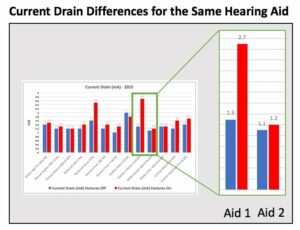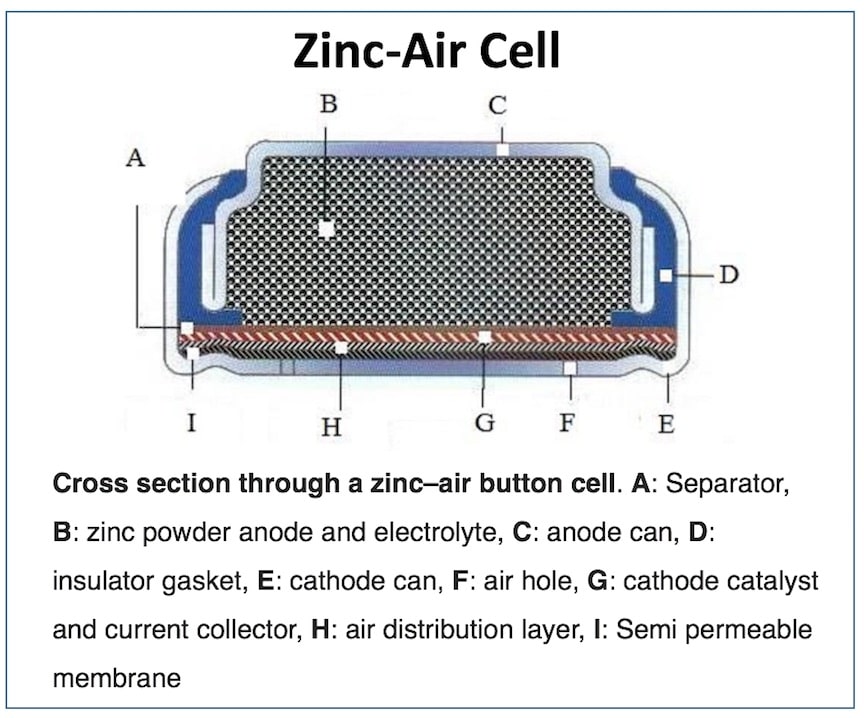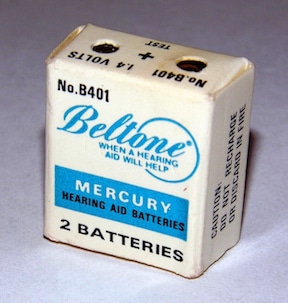Hearing Aid Battery Life is Not Easy to Predict
The past three weeks this post has been devoted to hearing aid battery life, because those who recommend and fit hearing aids quite often receive complaints from customers about how the battery life doesn’t last as long as they were led to believe. Last week’s post showed the resultant current drain of a number of hearing aids measured over the past six years, with advanced signal processing activities turned “Off” and “On.” A definite difference was measured with the current drain higher when these advanced signal processing algorithms were activated, resulting in expected shorter battery life.
This post will look at this topic again, but in a way that is directly meaningful to how increased current drain affects expected battery life. Specifically, it will look at three common hearing aid cell sizes, Size 10, 312, and 13, and show some examples of what a user might expect when the hearing aid circuitry is asked to do more.
Comparison Conditions

Figure 1. Current drain differences for two hearing aids with advanced signal processing features turned “Off” (blue) and “On” (red).
Current drain conditions for the year 2015 measurements posted last week are used for these comparisons (Figure 1). These will represent the minimum and maximum difference in current drain from among the thirteen hearing aids measured between the “Features Off” and “Features On” conditions. The minimum current drain change from among the hearing aids was from 1.1 to 1.2 mA, a difference of 0.1 mA. The maximum current change measured was 1.3 to 2.7 mA, a difference of 1.4 mA. These may not seem like much of a change, but let’s wait and see what these differences translate to.
Calculated battery life at different current drains are plotted on the same graph (Figure 2) in this post for the size 10, size 312, and size 13 cells – the most commonly used sizes in hearing aids at this time. From these graphs, providing one knows what the current drain is for their particular hearing aid, anyone can determine how long the battery is expected to last – kind of.
Battery Current Drain to Calculated Battery Life
The calculated battery life for the three commonly-used hearing aid cell sizes (sizes 10, 312, and 13) is provided in Figure 2. These are based on the mAh capacity provided in a previous post. Note that different battery companies may use mAh capacities slightly different than those used. Regardless, the general trend holds for all of them. Using the minimum current change from advanced circuit features “Off” to advanced features “On” (current drain from 1.1 to 1.2 mA), and then the maximum current change under the same conditions (1.3 to 2.7 mA), the information in Table I was calculated.

Figure 2. Calculated battery life (in hours), at different hearing aid battery current drain for the size 10, size 312, and size 13 cells/batteries. The higher the current drain (higher numbers), the lower the battery life in hours.
The impact on the battery life of the changes for the conditions identified in Figure 1 is shown in Table I. Going from 1.1 to 1.2 mA when the advanced features were activated, had a minimal impact on battery life (light blue shading), but still seven hours less for the size 10, ten hours less for the size 312, and sixteen hours for the size 13 cell. This translates roughly to 1, 2, and 3 days less for the 10, 312, and 13 cells respectively. On the other hand, when the maximum current drain change hearing aid example is calculated for battery life (light orange shading), the battery life is essentially halved.

Herein Lies a Problem
The number of hours listed in Table I does not translate into the number of hours of battery life one actually gets. That depends greatly on the number of hours the aid is used during the day, and on other demands on the hearing aid circuitry (high incoming sound levels to the hearing aid microphone, use with telecoil loops, the number of hours per day the aid is used – things not necessarily related to advanced signal processing features of the aid.) For example, if a person uses their hearing aid only 4 hours per day, the actual number of hours of actual amplification they get will be less than a person who uses their hearing aid 12 hours a day. The reason is because the battery is losing charge even when not in use. Therefore, a person who uses their hearing aid once per week, using a size 10 or 312 cell, may have to use a new battery every time they use the hearing aid. Why this occurs can be explained in part by what follows.
Unfortunately, Battery Life is Related to Additional, Uncontrollable Factors
 In addition to the impact of heaing aid circuitry current drain, other factors impact a hearing aid’s life. These comments are related to the zinc-air cell (Figure 3), which is what is used in hearing aids currently. This post will not go into great detail, but highlight certain issues that impact the battery’s performance, basically unrelated to the hearing aid user.
In addition to the impact of heaing aid circuitry current drain, other factors impact a hearing aid’s life. These comments are related to the zinc-air cell (Figure 3), which is what is used in hearing aids currently. This post will not go into great detail, but highlight certain issues that impact the battery’s performance, basically unrelated to the hearing aid user.
Activation
Zinc-air cells are activated as soon as the tab is removed, allowing air to enter and activate the cell. Once that occurs, the activation process cannot be stopped or reversed. Even though the tab has been removed, the cell doesn’t actually discharge until it is put into use. However, other factors come into play that result in rendering the cell incapable of performing its intended function – that of powering a hearing aid – even if never placed in a hearing aid. Its actual battery operating life is dependent on its interaction with its environment – especially air, temperature, humidity, and altitude, aside from the current drain of a hearing aid circuit. Under certain conditions related to these environmental conditions, the electrolyte and other activities within the cell are impacted. How long does it take for these factors to render a cell inoperable without it even being used, once the tab is removed? The answer to that is quite complex.
Performance
For example, in high temperature and low humidity the electrolyte in the cell loses water more rapidly, tending to dry out. In high humidity, excess water accumulates in the cell through the air holes (the electrolyte is deliquescent, meaning that it can absorb moisture much like a sponge), flooding the cathode and destroying its active properties. In other words, what happens is that the cell either dries out or fills with water, and can even cause corrosion or give the appearance of something oozing from the holes in the battery.
In low temperature, the battery’s voltage drops, reaching its end of life sooner. Hearing aids are designed to operate down to approximately 1 Volt. Below that, the circuit does not behave properly.
With altitude increases, the percentage of oxygen in the air is reduced, meaning that if you are high in the mountains, there is less oxygen in the air and the zinc-air cell may reach the end of its life cycle sooner. A combination of high altitude and low temperature can have a compounding effect on having the battery die sooner.
Miniature zinc-air cells, once exposed to air (including carbon dioxide), therefore have a high battery self-discharge. Self-discharge means that the internal chemical reactions reduce the stored charge of the cell without any connection between the electrodes (cathode and anode). This renders them to initially have less than a full charge when actually put into use.
Summary
So, how long can one expect their hearing aid battery to last? It depends on a number of factors, most not related to the user. The hearing aid current drain is important, but so are environmental conditions to which the cell is exposed. A full discussion of hearing aid batteries awaits another day.







Believe me if your heaing is as bad as mine the last thing in this world is worry re battery life. What is of real interest is the quality and strength of the sound from the hearing aid. It stands to common sense that the so improved performance in today’s AIDS must be attained by something that is of course power. I have the latest and most powerful ReSound am blown away by them. I hear the T V as clear as can be,nothing round my neck and can be aware of what is going on around me I mean hear someone speaking to me with reasonable clarity at the same time.
Have not been able to use a mobile for some time now it talkes right in my head without the need to make any adjustments.
Another add on is the “mini Mike” (expensive but worth it). Was at a meeting today the speaker was kind enough to clip it on his jacket and for first time in years was able to follow every word,beats any loop system by a mile. Another use is in car between driver and passenger. There is a car setting on the aid itself but mini Mike is so much better. If new batteries are needed ever 4 to 5 days so be it. I do understand that a lot is being done to improve power storage at this time but right now I will settle for existing available method.
If anyone would like to hear more or quiz me feel free to do so,I live in Northern Ireland.
Any you have no issues with batteries letting you down in these situations you describe? If not then I would love to know the model and form factor of aid you are using. I have an ITE from a competitor that also offers various streaming devices. I can’t use any of them because as soon as I engage the wireless reception the battery in my aid(s) will die soon after. Then I’m left in a worse situation than I started with.
What is needed for a A full discussion of hearing aid batteries?